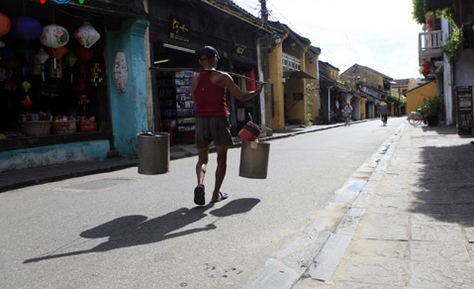(VOVworld)- Wells have become uncommon in rural Vietnam as water taps have replaced them. But in Hoi An, the locals still use water from wells to cook and make tea and coffee. Today, in our Culture segment, we tell you about the ancient wells which remain a vital aspect of Hoi An culture.
The people of Hoi An are still making tea and coffee and cooking noodles with well water. The famous Ba Le well and the wells of the Tran and Luu families are maintained out of pride in their tradition. Vo Hong Viet works for the Hoi An Culture Preservation Centre: “Hoi An still has numerous ancient wells, especially in the old town. The Ba Le well, and the other wells are 100 to 200 meters apart. We have a modern water supply system now, but we still use well water to cook. Water from the Ba Le well is pure and fresh and makes food more delicious”.
Local elders say that the Ba Le well was dug by the Cham people between the 8th and 9th century. Hoi An people often use water from Ba Le well to prepare feasts on the first day of the lunar month and on full moon days and to bathe new-born babies. Visitors to Hoi An never miss the chance to eat Cao Lau noodles and sweet black sesame soup or to visit the Ba Le well, which is more than one thousand years old. Mr. Viet told us: “Most local people get water from the Ba Le well for their daily cooking because they believe the water will make their food more delicious. Some people carry water from the Ba Le well to restaurants, cafes and hotels”.
 |
There are approximately 80 ancient wells in Hoi An. Though Hoi An is near the sea, the water in the local wells is fresh and plentiful even on dry days. Viet says there are three types of wells in Hoi An: round, square and round at the top but square at the bottom. Bricks are used to line the wells. Though they have different shapes, all of them have a wood frame at the bottom. The frame ensures the well’s durability by supporting its walls. Mr. Luu Hung said: “When we built the family clan house, we built this well. We preserve this well as a heritage of our ancestors. We mixed lime with catus thorns to build the well. We used four 25-meter planks of iron wood to strengthen the 4 corners of the well. The wood remains solid even today”.
Next to the wells are altars worshiping Well Genie. Hoi An people believe each well has a genie to protect it. Mr. Hung said: “Many people had bad luck after filling their wells. On the first day of every lunar month, we burn incense to worship the well genie. In Hoi An, we worship 5 genies: Prosperity, Kitchen, Well, Land and Gate genies. People worship the Well Genie to ensure good layers of earth in our houses. On the altar of the Well Genie, we burn incense, place lamps, and prepare fruits as we do at home to worship our ancestors”.
To the Bridge (Cau) pagoda, the Hoai river, and the ancient houses, temples, and pagodas, we must add ancient wells as tangible cultural heritages of Hoi An.